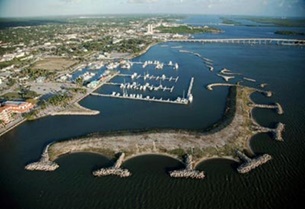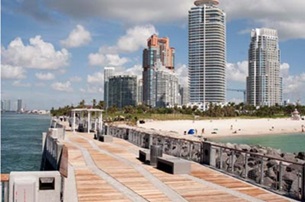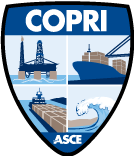The 2016 COPRI Project Excellence Award winners are Large Project: Fort Pierce City Marina, submitted by Tetra Tech; and Small Project: South Pointe Park Pier, submitted by Atkins. Congratulations to our awardees!
Large Project: Fort Pierce City Marina

The Fort Pierce City Marina was severely damaged when Hurricane Francis moved through the central east coast of Florida in 2004, so the project team knew that a stronger, more resilient design was required for the reconstruction.
Located in sensitive coastal habitat, the design also needed to avoid impacts to existing resources and address regulatory constraints on filling open water.
Numerical hydrodynamic and physical modeling tools were used to optimize the structural/functional performance while maximizing the environmental enhancement of the project.
Going beyond just avoiding impacts, the project creates 13 acres of nature-like breakwater islands with more than 21 acres of environmental enhancements including oyster habitat, mangrove plantings, dune grass plantings, seagrass habitat improvements, and shorebird nesting habitat. These biologic elements tie in with the rock of the rubble mound islands to create a system that will become stronger over time.
The project is also recognized for its beneficial reuse of dredged material: all of the sand for the construction of the large dune-like island was dredged from existing navigation channels (30,000 cubic yards) or reclaimed from dredged material management areas (120,000 cubic yards).
Small Project: South Pointe Park Pier

As one of the first sights a maritime visitor to Miami will see, the South Pointe Park Pier (pictured left) is a fitting introduction to this dynamic city.
More important than its good looks, the South Pointe Park Pier replacement returned a valued asset to the local South Beach community after the previous pier's decade-long closure for its deteriorated condition.
The project was challenging due to its location in one the highest hurricane impact zones, limited land-side access, sensitive coral habitats, and high interest in the local and regulatory communities.
Slightly longer and wider than its predecessor, the new 450-foot pier is grounded by 63 concrete piles interwoven between the old foundations.
Build for a 50-life, the concrete superstructure-composed of precast concrete piles, caps and beams, and cast-in-place caps-was designed with careful consideration to the rolling, slamming, and breaking wave effects of Category 5 hurricanes on the different elements of the structure.
The pier's stylistic deck employs Ipe Brazilian hardwood planks over aluminum load-bearing panels, which are designed to break away during strong hurricane events to reduce the superstructure damage from waves crashing underneath the pier and contribute to the ability to withstand a Category 5 hurricane.
The renovation creatively incorporates new viewing areas, shade structures, turtle-safe lighting, entry gates, fish-cleaning stations, and pedestrian plazas.


